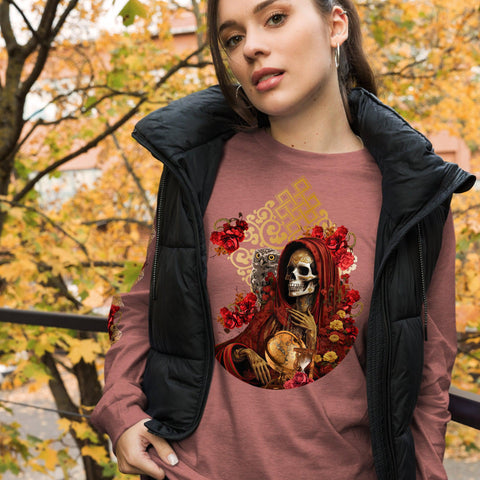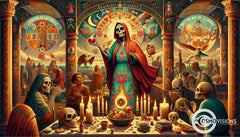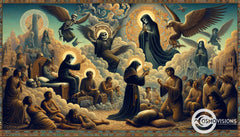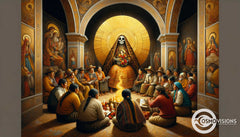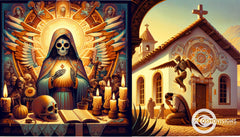The Meaning and Symbolism of Red Santa Muerte in Mexican Folk Catholicism
Posted by Luciano Martucci
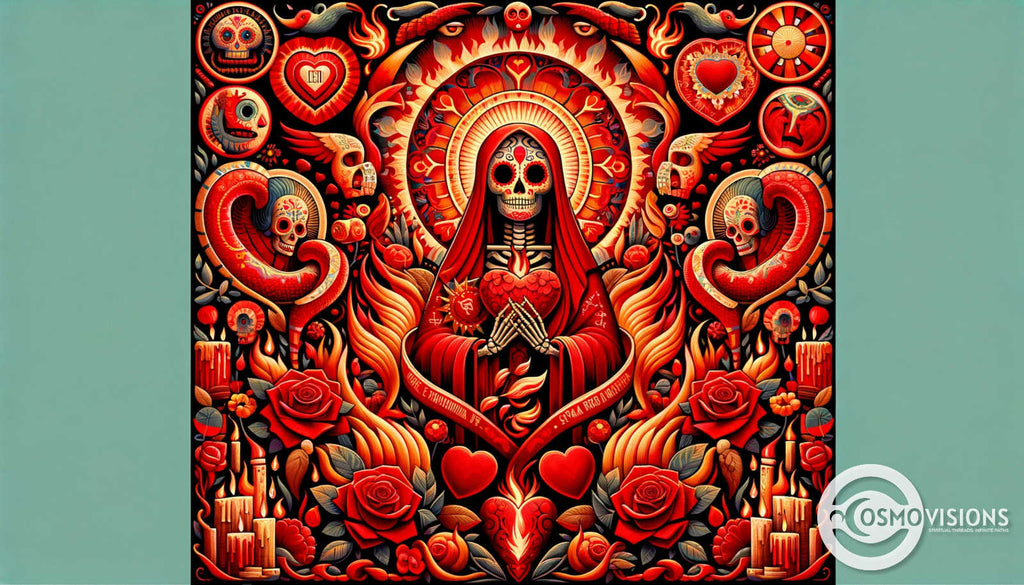
Welcome to a journey through the vibrant hues and profound meanings of one of Mexico's most enigmatic spiritual figures: Santa Muerte. Often shrouded in mystery, this sacred icon stirs deep feelings of wonder and curiosity across cultures.
You might be seeking to understand the complex tapestry of symbols that define her or simply intrigued by her striking red imagery.
Santa Muerte, or Holy Death, is a powerful symbol in Mexican Folk Catholicism revered for offering protection and guidance. Red, her most passionate color, evokes intense emotions tied to love and relationships.
This blog post will unravel the significance behind the fiery Red Santa Muerte, providing insights into how she influences devotion and daily life.
Our exploration will cast light on traditions often misunderstood yet deeply rich with cultural heritage. Discover how embracing Santa Muerte's red aspect can impact your spiritual path.
Ready to delve into a world where fervor meets faith? Keep reading; an enlightening experience awaits.
Understanding Santa Muerte
Santa Muerte has deep roots in Mexican Folk Catholicism and holds great significance in the culture. Understanding her history and role in spirituality is important for gaining insight into her symbolism and rituals.
Brief History
Santa Muerte, often known as Saint Death, traces its roots to an intricate tapestry of indigenous Mexican beliefs and Spanish colonial Catholic practices. Historians suggest that this revered figure emerged from the syncretism of ancient Mexica (Aztec) death deities with aspects of European Christianity brought by Spanish conquistadors.
Over time, devotees blended these traditions into a unique form of veneration.
Over the centuries, folk saint Santa Muerte has grown in prominence within Mexican spirituality and culture. Although not officially sanctioned by the Catholic Church due to her association with death and the afterlife, many people across Mexico have adopted her as their patroness.
She offers solace and protection to those who feel marginalized by society or ignored by other religious figures like The Virgin of Guadalupe—another dominant emblem in Mexican religiosity.
Withstanding criticism from some conservative sectors for allegedly promoting "devil-worship," Santa Muerte continues to be a powerful symbol for countless individuals seeking guidance through life's hardships.
Importance in Mexican Folk Catholicism
Mexican Folk Catholicism blends indigenous traditions with colonial-era religious practices, and Santa Muerte stands as a powerful symbol in this fusion. She embodies the resilience of belief systems that have adapted over centuries, merging pre-Hispanic spirituality with Catholic tenets.
As a folk saint, she has secured a significant place among many Mexicans who feel disconnected from the official church yet seek solace in familiar spiritual figures. Her followers turn to her for help with matters overlooked by traditional saints—desires and problems often considered too taboo or desperate.
Santa Muerte's devotees come from diverse backgrounds, finding common ground in their reverence for her as a protector and provider. They see her not only as La Parca, an iteration of the grim reaper but also as an entity akin to the Virgin of Guadalupe: compassionate and merciful.
This duality is essential to understanding how deeply ingrained she is within Mexican spirituality, transcending mere superstition to become part of daily life for millions seeking guidance and protection outside conventional channels.
Her importance reveals much about contemporary spiritual needs in Mexico’s ever-evolving cultural landscape, seamlessly transitioning us into exploring how colors play into Santa Muerte symbolism.

The Symbolism of Colors in Santa Muerte
Each color in Santa Muerte holds a specific meaning, reflecting different aspects of life and spirituality. Understanding the symbolism of red in particular can provide insight into the significance of this color within Mexican Folk Catholicism.
General Meaning of Colors
In the vibrant practice of Santa Muerte, colors hold deep meanings and signify various aspects of life. Red, for instance, pulses with the energy of love and family bonds, playing a significant role in rituals to strengthen relationships.
White stands as a beacon for purity and offers spiritual cleansing to those seeking solace or new beginnings. It is used extensively by followers who aim to clear negativity and invite positive energies.
Meanwhile, black carries the weight of finality and loss but also serves as a protective shield against harm. It symbolizes endings that make room for rebirths, compelling many devotees to look upon it during times of transition or when they wish to cut ties with harmful influences.
The palette of Santa Muerte is a rich tapestry that weaves together the practical concerns and spiritual aspirations of believers from all walks of life.
Specific Symbolism of Red
Red holds significant symbolism in the context of Santa Muerte, representing love and family. Within Mexican folk Catholicism, the color red signifies specific responsibilities and duties associated with Santa Muerte worship.
It embodies protection and eternal vigilance, deeply ingrained in cultural practices and devotion, making red an essential aspect of Santa Muerte's symbolism in Mexican folk Catholicism.
The specific symbolism of red is central to understanding the intricate nuances of devotion and ritual within Santa Muerte worship. Embodying love, family, protection, and responsibility within its vibrant hue, the color red represents a profound connection to faith and spirituality for followers of Santa Muerte.
The Role of Santa Muerte in Various Sectors
Santa Muerte holds significance in various sectors, including her association with the LGBTQ+ community and her role in providing protection across different walks of life. Additionally, there is also a connection with criminality that adds to the complex role of Santa Muerte in Mexican Folk Catholicism.
Association with the LGBTQ+ Community
Santa Muerte is revered as a saint and protector of the LGBTQ+ community in Mexico. With a large following among LGBTQ individuals, Santa Muerte holds a zero-tolerance policy against discrimination, making her an essential figure for homosexual, bisexual, and transgender people.
Moreover, she is frequently invoked during same-sex marriage ceremonies in Mexico due to her reputation as a guardian and advocate for marginalized communities.
Santa Muerte's Protection across Different Walks of Life
In addition to being associated with the LGBTQ+ community, Santa Muerte offers protection and guidance across various walks of life. Followers from different backgrounds seek her intercession for safety and support in their daily lives, reflecting the universal appeal of her protective nature.
From marginalized individuals living outside traditional religious structures to those seeking solace in times of hardship, people turn to Santa Muerte as a source of comfort and empowerment.
Santa Muerte's devotees come from diverse sectors, including those who feel disconnected from mainstream religions or society. They find solace in her inclusive and comforting presence, drawing strength from her role as a protector of all people regardless of their circumstances.
Connection with Criminality
The worship of Santa Muerte has been linked to greater levels of criminal activity. Criminal connection with the cult often involves seeking supernatural powers or gaining favor, such as vast riches or the death of an enemy.
The cult has been associated with sensationalized crimes in Mexico and has garnered attention due to its involvement in crime scenes featuring altars and ritualistic activities. This connection between criminality and the worship of Santa Muerte is a complex aspect that continues to spark interest and controversy among followers, law enforcement agencies, and researchers.
Involvement in this form of worship can lead individuals down paths that blur moral boundaries, ultimately leading them into conflict with legal authorities. The allure of power and fulfillment of desires through religious practices may create an environment where illicit actions are seen as justified or necessary for personal gain.

The Rituals Associated with Santa Muerte
Rituals associated with Santa Muerte include the use of votive candles and visiting places of worship to pay respect and seek protection. These rituals play a significant role in the practice of Mexican Folk Catholicism and reflect the deep spiritual connection between believers and Santa Muerte.
Use of Votive Candles
Votive candles play a significant role in the rituals associated with Santa Muerte in Mexican folk Catholicism. These candles, often placed in glasses and of fatter veladoras variety, are used as an integral part of worshiping Santa Muerte.
Historically, Catholics have relied on the lighting of votive candles and engaging in devotional practices to seek intercession from saints, including Santa Muerte herself.
Adorning altars as offerings or as requests for blessings or protection, these votive candles serve not only as sources of light but also represent the believers' intentions and petitions to Santa Muerte.
Places of Worship
Shrines dedicated to Santa Muerte are commonly found in public spaces such as cemeteries, street corners, and marketplaces. Devotees of Santa Muerte often gather at these shrines on specific days to perform rituals and ceremonies.
These places of worship serve as central meeting points for the community of devotees, where they come together to express their faith and seek protection from Santa Muerte.
In addition to public shrines, many individuals also maintain private home altars dedicated to Santa Muerte. These personal places of worship allow devotees to connect with the saint in a more intimate setting, offering a space for prayer and offerings.
The Red Santa Muerte and Love and Passion
The Red Santa Muerte holds significance in matters of love, passion, and relationships in Mexican Folk Catholicism. Its interpretation and impact on one's love life make it an intriguing aspect of Santa Muerte worship.
Interpretation of Red Santa Muerte
Red Santa Muerte, symbolized by a red candle in Mexican folk Catholicism, represents love, lust, and passion. Devotees often use the red candle for love magic and rituals associated with matters of the heart.
The color red is significant as it embodies the intense emotions that come with romantic relationships and serves as an essential tool for those seeking assistance with love-related situations.
In working with prayer and magic devoted to Santa Muerte, followers utilize the red candle for love-binding spells and to attract affection from others.
The interpretation of Red Santa Muerte reflects its role in guiding devotees through various aspects of their personal lives, particularly when it comes to feelings of affection and intimacy.
How Red Santa Muerte Affects Relationships and Love Life
The red Santa Muerte holds a significant place in the realm of love and passion. Its vibrant color symbolizes ardor, attracting individuals seeking affection and romantic success. Devotees believe that through prayers and rituals to the red Santa Muerte, one can invoke its influence to bring passionate love into their lives.
This form of Santa Muerte is associated with empowering relationships and enhancing the emotional aspect of love.
In rituals and prayers, the red Santa Muerte serves as a beacon for those seeking fervent connections and deep bonds with their partners. Followers turn to this symbol to imbue their romantic endeavors with intensity, aiming to cultivate ardent love in their relationships.
Opposition and Persecution of Santa Muerte Worship
Santa Muerte's worship has faced opposition and persecution from the Catholic Church, which condemns it as satanic. In Central Mexico, there was a crackdown on the cult of Santa Muerte in 2005, leading to its disappearance.
This persecution mirrors the Church's campaign against evangelical and Pentecostal churches, showing a pattern of opposition to non-traditional religious practices. The connection between the persecution of Christians and the worship of Santa Muerte highlights how both have been condemned and faced resistance.
In summary, Santa Muerte has encountered strong opposition and condemnation from traditional religious institutions, particularly the Catholic Church. This is evidenced by its disappearance following a crackdown in Central Mexico in 2005 and parallels drawn with campaigns against other non-traditional religious groups such as evangelical and Pentecostal churches.

The Impact of Santa Muerte in the United States
Despite opposition and persecution, Santa Muerte has made a significant impact in the United States. Her presence is particularly felt among the growing Latino population, who have brought their religious practices with them from Mexico.
As her worship spreads across the border, it sparks debates about cultural exchange, religious freedom, and the influence of Mexican folk Catholicism on American society.
Law enforcement officials in the United States have associated Santa Muerte's worship with criminal activities such as drug trafficking and illicit behavior. This has led to discussions about how her presence may be affecting social dynamics and moral values within communities.
Moreover, scholars believe that her popularity in the United States reflects a blending of traditions between Mexican culture and American society. The impact of Santa Muerte raises questions about how different belief systems interact and shape cultural landscapes within diverse societies like that of America.
Santa Muerte Statutes
The Santa Muerte statues hold immense significance in Mexican Folk Catholicism, with each color representing different aspects of life and spirituality. The red Santa Muerte statue, in particular, is associated with love and passion, playing a crucial role in relationships and love life.
Overview of Santa Muerte Statutes
Santa Muerte statutes depict the skeletal figure of Santa Muerte adorned in various colors, each representing different aspects of life. These statues are an essential part of Santa Muerte worship, often used for creating personal altars or shrines.
The red Santa Muerte statue, in particular, symbolizes love and passion and is associated with matters of the heart. It represents a strong connection to relationships, attracting passionate love, and providing protection for romantic endeavors.
The importance of these statues extends beyond just religious symbolism as they also serve as focal points for offering prayers and making requests to Santa Muerte. Many practitioners believe that having a physical representation in the form of a statue aids in strengthening their spiritual connection to La Santa Muerte.
Importance of Red Santa Muerte Statue
The red Santa Muerte statue holds significant importance in Mexican folk Catholicism, symbolizing love, passion, and matters of the heart. It is revered as a powerful intercessor in romantic relationships and emotional well-being.
Followers seek guidance and support through rituals and prayers related to love and relationships, believing in its ability to bring emotional fulfillment.
Mexican culture embraces the red Santa Muerte statue as a potent symbol of love, where individuals turn to her for assistance in matters of the heart. This vivid representation encapsulates the emotional aspects of life, offering solace and hope while seeking love's guidance.







